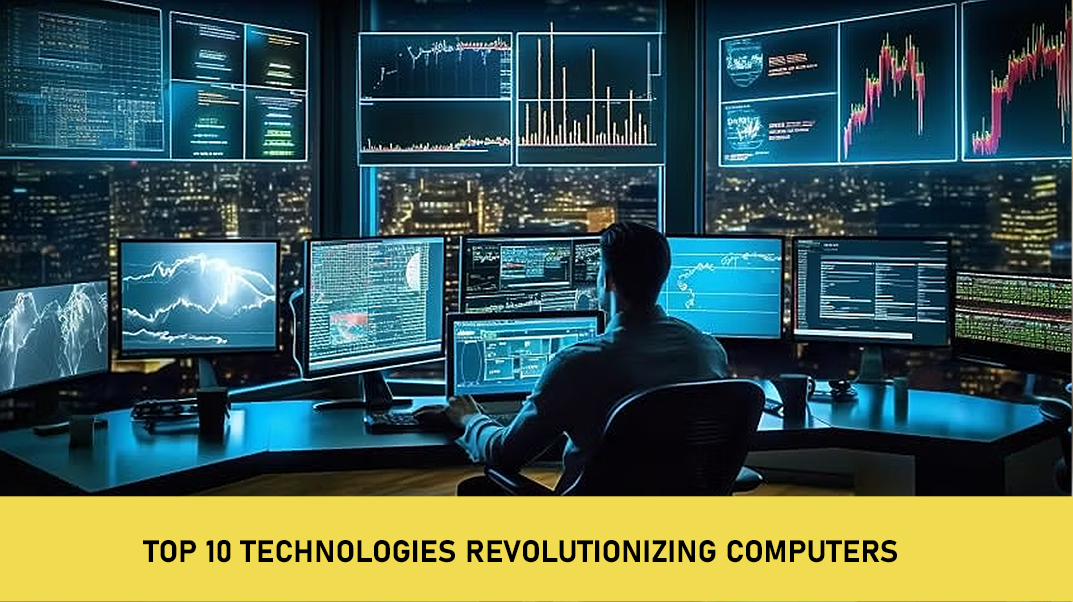Top 10 Technologies Revolutionizing Computers
The rapid pace of technological advancement has significantly transformed the world of computing. Today’s computers are far more powerful, efficient, and versatile than ever before, thanks to groundbreaking technologies that continuously push the boundaries of what’s possible. Here’s a look at the top 10 technologies revolutionizing computers, each contributing to the evolution of modern computing and shaping the future.
1. Artificial Intelligence (AI) and Machine Learning (ML)
Artificial Intelligence (AI) and Machine Learning (ML) are at the forefront of technological innovation, driving significant changes in how computers process data and make decisions. AI enables machines to perform tasks that typically require human intelligence, such as recognizing patterns, understanding natural language, and making predictions. ML, a subset of AI, involves training algorithms to learn from data and improve their performance over time. These technologies are enhancing a wide range of applications, from automated customer service and fraud detection to advanced analytics and autonomous systems.
2. Quantum Computing
Quantum computing represents a paradigm shift from classical computing, leveraging the principles of quantum mechanics to process information in fundamentally different ways. Unlike classical bits, which represent data as either 0 or 1, quantum bits (qubits) can exist in multiple states simultaneously. This allows quantum computers to tackle complex problems and perform calculations at unprecedented speeds. While still in its experimental phase, quantum computing holds the potential to revolutionize fields such as cryptography, drug discovery, and complex system simulations.
3. Edge Computing
Edge computing brings computation and data storage closer to the source of data generation, rather than relying on a centralized data center. By processing data locally on devices or edge servers, edge computing reduces latency and improves performance, especially for applications requiring real-time processing. This technology is particularly beneficial for the Internet of Things (IoT), autonomous vehicles, and smart cities, where quick data analysis and response are crucial for operational efficiency and user experience.
4. 5G Technology
The rollout of 5G technology is transforming the landscape of mobile and wireless computing. With its ultra-fast data transfer speeds, low latency, and increased network capacity, 5G is enabling new possibilities for connectivity and communication. It supports a wide range of applications, including augmented reality (AR), virtual reality (VR), and the expansion of IoT devices. The enhanced speed and reliability of 5G technology are driving advancements in fields such as remote healthcare, smart manufacturing, and autonomous transportation.
5. Blockchain Technology
Blockchain technology, known for its role in cryptocurrencies, is revolutionizing how data is stored and verified. A blockchain is a decentralized, immutable ledger that records transactions across a network of computers. Each block in the chain contains a set of transactions, and once added, it cannot be altered. This technology ensures transparency, security, and trust in digital transactions, with applications extending beyond cryptocurrencies to include supply chain management, digital identity verification, and smart contracts.
6. Augmented Reality (AR) and Virtual Reality (VR)
Augmented Reality (AR) and Virtual Reality (VR) are immersive technologies that are reshaping how we interact with digital content. AR overlays digital information onto the real world, enhancing user experiences with interactive elements and contextual information. VR, on the other hand, creates a fully simulated environment that users can explore and interact with. Both technologies are making significant impacts in sectors such as gaming, education, training, and remote collaboration, offering new ways to engage with and visualize information.
7. Cloud Computing
Cloud computing has transformed how computing resources are accessed and managed. By providing on-demand access to computing power, storage, and applications over the internet, cloud computing offers flexibility, scalability, and cost-efficiency. Major cloud service providers, such as Amazon Web Services (AWS), Microsoft Azure, and Google Cloud, enable businesses and individuals to deploy, manage, and scale applications with ease. Cloud computing supports various use cases, from data storage and backup to advanced data analytics and machine learning.
8. Cybersecurity Technologies
As cyber threats become more sophisticated, advancements in cybersecurity technologies are crucial for protecting sensitive information and ensuring the integrity of digital systems. Modern cybersecurity solutions include advanced threat detection systems, encryption techniques, multi-factor authentication, and security information and event management (SIEM) tools. These technologies help safeguard against data breaches, cyberattacks, and unauthorized access, providing enhanced security for personal and enterprise environments.
9. Natural Language Processing (NLP)
Natural Language Processing (NLP) enables computers to understand, interpret, and generate human language. NLP technologies facilitate human-computer interactions by allowing machines to process and respond to natural language inputs. Applications of NLP include chatbots, language translation services, sentiment analysis, and voice-activated assistants. By improving how computers handle language, NLP enhances user experiences and enables more intuitive interactions with technology.
10. Advanced Semiconductors
Advancements in semiconductor technology continue to drive improvements in computer performance and efficiency. Modern semiconductors, such as advanced processors and memory chips, enable faster processing speeds, lower power consumption, and greater integration of features. Innovations in semiconductor materials and manufacturing processes are pushing the limits of what’s possible, leading to more powerful and energy-efficient computers that support a wide range of applications.
Conclusion
These top 10 technologies are revolutionizing the world of computing, driving advancements across various industries and reshaping the digital landscape. From AI and quantum computing to blockchain and cybersecurity, each technology offers unique capabilities and opportunities. Staying informed about these innovations can help you understand their potential impacts, leverage their benefits, and stay ahead in the ever-evolving world of technology.



